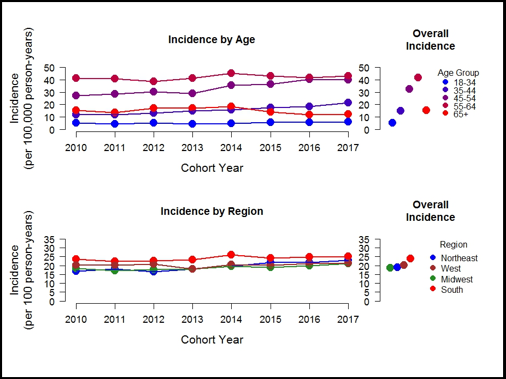We conducted a retrospective analysis of data in the IBM MarketScan™ Commercial Claims and Encounters database between January 2008 and December 2017. The MarketScan database contains de-identified longitudinal patient information, insurance features, financial information, inpatient and outpatient medical and prescription drug data. Epidemiologic results from such a large database provide more generalizable data compared to single-institution reports or self-reported surveys. Furthermore, by looking at participants’ age and geographic location, a broad view of how PD presents across the country is possible. We examined men ≥18 years old with a diagnosis of PD identified using ICD-9, ICD-10, and CPT codes. Index date of diagnosis was defined as the first physician visit with a diagnosis of PD during the enrollment period.
A total of 261,712 PD claims in 94,876 unique men were identified during the study period. Incidence rates were higher in men 55-64 years old at a rate of 41.6 per 100,000 men per year. When looking at geographic regions, the highest PD rate was observed in the Southern Region of the United States at a rate of 23.9 per 100,000 men per year, with prevalence following a similar trend. Furthermore, a risk analysis showed that men 55-64 years old were also more likely to be diagnosed with PD (RR 8.21; 95% CI 7.77, 8.66; p<0.001), likewise those residing in the Southern states (RR 1.30; 95% CI 1.25, 1.35; p<0.001).

Figure 1: Incidence of Peyronie’s Disease in the United States – stratified by age-group and geographic region.
We recognize some of the limitations of a commercial encounters and claims database, such as not being able to capture data for men with other types of insurance (e.g. Medicare) as well as those without insurance. However, despite these limitations, the results of this study provide a useful perspective on the rates of PD cases that enter the healthcare system. Regarding the significant regional variation observed, this study highlights the need for further in-depth research that investigates possible factors that may be driving such variation.
Written by: Odinachi Moghalu, DO, MS, Division of Urology, Department of Surgery, University of Utah School of Medicine, Salt Lake City, Utah, United States.
Read the Abstract


